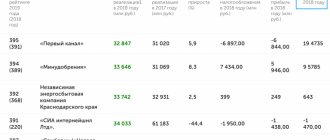04/23/2020 2 169 2 Reading time: 8 min. Rating:
Author
: Konstantin Bely
In today's publication we will talk about a very important economic indicator, which can be called a direct indicator of the standard of living - real income of the population . What is it, how is this indicator calculated, what does it characterize and why is it so important, as well as how the real incomes of the Russian population have changed from 2000 to the present - you will know and understand all this after reading this article. I will try not to go deep into formulas, but to explain them in simple words that can be understood even by people far from finance and economics.
The essence of the concept
In a simpler form, we can say that income is the amount of money received in a certain unit of time for performing a certain job. For example, 20 thousand/month. Sources of income can be:
- Salary (time and piecework).
- Other income of employees from enterprises other than wages: bonuses, rewards, etc.
- Income from business activities.
- Income from the disposal of private property.
- Income from sales of the currency of another country at a higher rate than the currency was purchased.
- Other miscellaneous income.
Types of income - gross and net
Income is classified depending on the qualifying criteria. The main division is based on accounting principles. There are:
- gross income is cash received from core activities;
- net income is what remains of the gross after paying VAT, excise and customs duties.
And once again to reinforce the difference between gross income and profit:
Transfers
In addition to economic activities, income may come in the form of transfers. Let's explain this part in more detail.
Transfers mean the giving of certain benefits by one person to another for free. Transfero is also translated as “to move” or “to transfer.” In this case, the transfer can be understood in a more general sense - a change in the location of funds in a certain form or only in their owner.
For example, the state pays pensions to older people - this is a transfer. In addition, such income includes:
- Wealth. This category includes inherited acquisitions: money, real and movable property, documents, etc.
- Fines.
- Voluntary donations and contributions from individuals and legal entities.
- Social payments: unemployment benefits, benefits for single mothers, disabled people, funeral benefits, child care benefits, etc.
- Social protection of the population (compulsory social insurance).
Income level of the population
For every country, the level of income of the population is important. It can be used to determine the welfare of the country with the greatest accuracy. Unlike per capita income, economists receive more detailed and truthful information, since indicators of average nominal, disposable and real income are used to assess income levels:
1. Nominal - in-kind or cash income received by a citizen of a country for a certain time for a certain job.
2. Disposable is nominal income minus mandatory payments to the state or private enterprises. Income that can be used by a citizen to meet needs.
3. Real - a certain amount of material goods (goods and services) that a citizen can purchase with the amount of real income for a certain time.
The term “level of income of the population” is inviolably associated with the people’s well-being, the degree of satisfaction of the spiritual and material needs of citizens. And most importantly, it is connected with the standard of living of the population. Thus, for economists, population income indicators have the following meanings:
- Comparison is a comparison of the values of individual indicators of citizens’ incomes in a time or geographic (between different territories, between countries) interval.
- Studying the impact of social change (for better or worse).
- Accounting for disparity in income between different segments of the population.
A little about calculations
Net income is calculated by subtracting from the money received the cost item used for the production and sale of a specific product.
Net present value. The entire amount of expenses is taken and subtracted from the entire amount of income at a specific point in time.
Operating income. This is gross profit minus operating expenses.
Example:
An entrepreneur bought goods for 400 thousand rubles. And he spent 200 thousand rubles on housing and communal services, renting premises, paying taxes and the salary fund. At the same time, the goods were sold for the amount of 800 thousand rubles.
We calculate net income: 800 thousand – 400 thousand – 200 thousand = 200 thousand.
This means that the entrepreneur’s profit will be 200 thousand rubles.
General form
Income is usually divided according to its type (form) and method of use. The population receives them in cash or in kind. Monetary form is wages, dividends, documents of value during sale (rights to own private property, movable property). The natural form is expressed in the households’ own production of objects necessary for life. For example, farmers grow carrots and potatoes (food) or flax and cotton in their gardens, which can be used to make clothes.
Income in kind is produced and used by consumers. For example: this type is typical for farms, private plots, individual small towns and villages in any country. We should not attribute natural gains only to countries with backward economies.
Cash income of the population is used by citizens to purchase ready-made material needs. This is the purchase of necessary goods and services.
Nominal, real and effective returns
I have a full course on portfolio investing.
I decided to organize the information from this course into a series of articles. The articles will be useful for those who want to structure investment information. The course touches on the theoretical aspects of investing and practical aspects of investing in the Russian stock market, foreign exchanges and cryptocurrency platforms. Course presentation video:
Let's start the course with theory. If we want to increase or decrease something, then first we need to learn how to measure an indicator. Let's understand the different concepts of profitability.
Real income
Real income of the population is a set of material goods, expressed in kind, that a consumer can purchase with his nominal income. Sometimes people confuse nominal and real income. Real earnings characterize the number of material goods purchased by a person, taking into account variations in retail prices, percentage of taxes, etc.
To determine the real income of the population with the greatest accuracy, it is necessary to subtract the mandatory costs of paying direct and indirect taxes and mandatory payments from the total amount of all earnings (cash + in kind). This refers to fees, excise duty, VAT, overpayment for services, etc.
It is worth noting that the real income of the population is an indicator of the life of society in a given country. For example, capitalist relations are characterized by rapid uneven growth in cash receipts and their sharp decline in certain periods. Such household incomes may decline for many reasons:
- Constant uncontrolled rise in prices for certain goods and services.
- Inflation (increase in the general price level).
During the formation of a social society, the overall level of real income gradually increases. However, it is worth remembering that revenues are distributed unevenly. In particular, in Russia, from 1940 to 1976, the income of farms and communities was much higher than that of workers in any factory. But compared to the beginning of the 20th century, the total real income of the same workers has increased by about 3.5 times. If we talk about the population as a whole, then almost 5 times.
Time series
In accordance with data from the Federal State Statistics Service, the dynamic series of these indicators are as follows for the last 6 years:
| Calendar year | Size in national currency |
| 2013 | 25.684 |
| 2014 | 27.412 |
| 2015 | 30.254 |
| 2016 | 30.865 |
| 2017 | 31.897 |
| 2018 | 33.178 |
| 2019 | 35.188 |
Naturally, the figures given reflect the situation exclusively for the country as a whole. But, despite their heterogeneity, it is still possible to navigate through them how the well-being of the population as a whole grew during the reporting period.
Per capita income
According to entrepreneurs, income is the excess of amounts from sales over the amounts required for production costs. And production costs include not only the purchase of all necessary materials, but also wages to workers, employees and managers. Thus, the average annual income of an individual in a country is per capita income. It is calculated based on the sum of all material assets for the year of persons of the same class.
Per capita income was coined as an economic term to indicate the wealth and economic status of a country. It can easily be used to determine the level of modernization and development of the country over any period of time.
An analysis of per capita income statistics in different countries of the world allows us to say with confidence that the majority of the world's population lives in countries with average earnings that do not exceed $350.
However, per capita income gives too general a picture and does not consider individual details. For example, according to statistics, average incomes cannot be used to determine the purchasing power of different segments of the population.
What if we consider underdeveloped countries? The average European spends most of his income on supporting his life. These are clothes, food, rent, etc. But in underdeveloped countries, many people live on self-sufficiency (grow food, sew clothes, build housing) and, therefore, spend a little differently on it. This means that these items will not be reflected in the national income of an underdeveloped state.
Finally, per capita income statistics for a country cannot provide reliable information about the state of a country if its income distribution is highly unequal. It's about the contrast between the poor and the rich.
What is the middle class
The middle class of the population structure is a social group of people that has a stable income. In this case, earnings fully satisfy basic needs in the material and social sphere. Their well-being provides for the needs of a decent quality of life.
In developed countries, the income of the middle class grows annually, which is determined not by an increase in income levels, but also by inflation, changes in the needs of the people, which creates a desire to earn more.
How much does the world's middle class earn?
In the presented cases, groups whose income is above the median are considered. Average salaries are shown before taxes and converted into rubles at the exchange rate for June 2022. Source: RBC.
Most academic institutes or banks conduct studies that stipulate income levels that should be in the middle class. Each time the indicators undergo significant changes. Thus, in 2015, a Swiss bank conducted its research and identified the leading country in terms of the number of people belonging to the middle class. This is China, and in second place is the USA. At the same time, the income of middle class people was taken into account. According to estimates, the figures were in the region of 100 thousand dollars per year. Switzerland has figures of about 73 thousand dollars per year per person, Russia – 18 thousand dollars, and Ukraine a little more than 11 thousand dollars.
Such indicators always surprise Russians. But it should be noted that when determining income for the middle class, average monthly earnings are taken.
Nominal income
The simplest type of income , nominal income, is the total amount of all income of an individual or enterprise from some activity. The nominal incomes of different segments of the population are formed according to certain patterns:
- Income in the form of wages, wages, or property income.
- Cash transfers from the state are transfers.
- Income received through the financial credit system: government insurance, bank loans, etc.
Going back a few years, to the early 90s, we can remember that at that time Russia had the lowest nominal incomes. According to average statistical data from Rosstat, monthly cash receipts did not exceed $22! Until about 1995, income conditions of extreme poverty persisted in Russia. But in 2006-2007, the Russian Federation again managed to return the economic situation of the population to the same level at which it was in 1990.
Forecast
According to forecasts, inflation will rise over the next 5 years. After all, the current economic situation and the situation on world markets indicate the approach of another global crisis.
Therefore, the government should be concerned about taking a number of measures aimed at preventing a deterioration in the living standards of citizens. Otherwise, a variety of demographic indicators will develop as negatively as possible, ranging from life expectancy to birth and death rates at a variety of age intervals.
Income of the population
The country's economy is firmly based on the income of each individual citizen. This means that it is necessary to raise the standard of living to the maximum possible. At the moment, the income of the Russian population is distributed as follows:
- Temporary and piecework payment - wages - 66.8%.
- Social insurance payments - 18.2%.
- Entrepreneurial income - 7.8%.
- Property disposal - 5.3%.
- Income of other types - 1.9%.
Incomes of the population of Europe and the CIS countries are distributed slightly differently. In the West, many more people are engaged in entrepreneurial activities and receive fewer social security benefits.
The highest level of income is observed in the countries of North America - Canada and the USA, as well as Australia. The average monthly income of residents of these states reaches $3,000.
The lowest level is in Central and Southern Africa. There is no reliable information about the income of many territories, and in other countries the average salary hardly reaches $100. However, it is worth remembering that agricultural production reigns on this continent, and it is not taken into account when calculating.
Increasing incomes of the population is the main task of the economy of any state. Each country, at a certain point in its existence, experienced severe economic crises, unrest in society due to a lack of resources, etc. But the rulers of all territories of the Earth, without exception, strive to improve the lives of the population and increase the average level of income.
Dynamics
As you can see, over the reporting 6 years, the average income level increased by less than 10,000 rubles, which amounted to about 40%. If we take into account the level of inflation, then, according to Rosstat, it looks like this:
- 2013 – 6.45%.
- 2014 – 6.7%.
- 2015 – 11.2%.
- 2016 – 2%.
- 2017 – 3.3%.
- 2018 – 4%.
- For 2022 -6.1%.
Moreover, it must be taken into account that these figures are calculated in relation to the previous year. Therefore, as can be seen from the data presented, inflation is outpacing the growth of the average per capita income of citizens. Naturally, this has the most negative impact on the standard of living, on the ability to purchase even a minimum food basket and provide the family with other necessary services.
How is the population's income distributed?
The primary distribution of income, also called functional in economics, begins with its distribution among the owners of factors of production. At different periods in different countries, different systems for shaping the distribution of income have operated and continue to operate, but in general there are four main aspects:
- Equalization assignment, or egalitarian distribution, is an attempt to equalize the incomes of all segments of the population. However, this aspect cannot be considered successful. Since the physical and mental abilities of individuals in one country vary greatly, egalitarianism will give rise to a situation where one works and the other eats.
- Distribution by market method. A more equitable way of distributing income, based on the social benefit of the product produced and sold by the entrepreneur. So it is impossible to establish an absolute balance in income, but their distribution will be fair.
- With the help of accumulated property. This distribution of income of the population manifests itself when receiving, accumulating and inheriting any part of the accumulated property: a house, securities, money, etc.
- Privileged distribution, most developed in countries with backward democracies. The simplest type of distribution, where rich officials and rulers autocratically redistribute income in their favor: they arrange higher salaries, pensions and other benefits for themselves.
Many people, living quietly within their own country, do not notice how the economic system guides them. And it is very good that the average person does not notice how the state interferes in the market economy.
If the majority of people feel that income is distributed unfairly, that someone is in charge of them, and that the workers’ own efforts do not bear any fruit, this is fraught with discontent among the lower strata.











